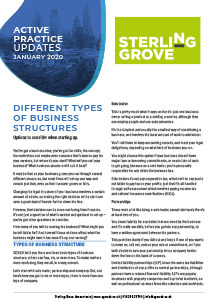Resource Hub
Different Types of Business Structures
Options to consider when starting up.
You’ve got a business idea, you’ve got the skills, the concept, the motivation and maybe even someone that’s keen to pay for your services, but where do you start? What will you call your business? What business structure will suit it best?
It may be that as your business grows you run through several different structures, but most firms will set up one way and remain just that, even as their turnover grows or falls.
Changing the legal structure of your business involves a certain amount of admin, so making the right decision at the start can save a good deal of hassle further down the line.
However, that decision can be more confusing than it seems. It’s not just a question of what’s easiest and quickest to set up – you’ve got other questions to consider.
How many of you will be running the business? What might you be left liable for? And how will these choices affect what the business might owe in tax once it’s up and running?
TYPES OF BUSINESS STRUCTURE
GOV.UK tells you there are three basic types of business structure; others say four, six, or even more. To make matters more confusing, they are all, in a way, correct.
Let’s start with sole trader, partnership and company. But, and here’s how you get to six or more types, there is more than one type of company.
Limited Company
If you’re already trading in some form, here’s what you’re probably interested in.
The major advantage of a company is that legally it’s a separate entity, and you’re not personally liable for its debts, although you may lose whatever funds you invested.
And here’s where it gets a little more complicated.
Lot of places offer to set you up a company off-the-shelf, but what they won’t do is talk you through your options, and which type of setup is right for you.
Sole trader
This is pretty much what it says on the tin: just one business owner selling a product or providing a service, although they can employ people and use subcontractors.
It’s the simplest and usually the smallest way of constituting a business, and involves the least amount of work to administer.
You’ll still have to keep accounting records, and meet your legal obligations, depending on what kind of business you run.
You might choose this option if your business doesn’t have major loan or borrowing commitments, or needs lots of cash to get going, because as a sole trader, you’re personally responsible for any debts the business has.
Sole traders do not pay corporation tax, which isn’t to say you’re not liable to pay tax on your profits, just that it’s all handled through self-assessment which involves paying income tax and national insurance contributions (NICs).
Partnerships
These work a lot like being a sole trader, except obviously there’s at least two of you.
You share liability for any debts that are owed by the business and it’s really sensible, before you go into any partnership, to have a written agreement between the partners.
This provides clarity if you fall out and helps if one of you wants to move on, sell out, reduce your role or commitment, or if you both decide to turn your partnership into a company further down the line on the back of success.
Limited liability partnerships (LLP) share the same tax liabilities and distribution of any profits as normal partnerships, although partners have a reduced financial liability. LLPs are popular structures with property companies and buy-to-let landlords, as well as professional services firms like solicitors and architects.
TYPES OF COMPANY
Realistically, there are a few options you’re likely to consider.
The first is a company limited by guarantee, the second a company limited by private shares, and the third is a community interest company (CIC).
The fourth is a public limited company (PLC), but that’s probably less relevant if you’re just starting.
Company limited by guarantee
This is the smallest kind of company structure, and doesn’t involve any share capital. As such, this structure is usually adopted by not-for-profit organisations.
Members are usually the directors, who have a limited liability if the company goes into liquidation.
Unlike a partnership, if one director wants to move on, it does not fundamentally change the shape of the company, so it’s sometimes easier to change personnel.
Company limited by private shares
This is a company with shares that are privately traded and held.
In most cases, shareholders are liable for the company’s debts up to the extent they have invested.
The advantage of this structure is that it allows capital to be raised by share issue, which you may want if your business has significant investment needs.
Unlike a PLC, this structure allows business owners more control over who holds the shares.
Community interest company A CIC is a company that’s not set up for private profit, so you’re
not allowed to take money out as shares or dividends.
That’s not to say it doesn’t pay salaries, or reinvest profit back into its social goals.
CICs are sometimes perceived as being on the borderline between charities and businesses.
Some are owned by charities, social enterprises or trading arms, to raise funds, or to help train or employ vulnerable people.
Public limited company
Shares in PLCs are openly traded and sold. It’s usually a stage that you’d move to once you were up, running, and at least reasonably successful – you need a minimum of 50,000 in share capital.
NOTIFYING AUTHORITIES & PAYING TAXES
If you’re a sole trader or partner, you’re mostly going to have to report back to HMRC. Companies House is a separate body that maintains all the records of companies.
Regardless of the size of your company, you’ll have to file accounts, a corporation tax return, and a confirmation statement letting them know who the directors of your company are, as well as any major shareholders if relevant.
Corporation tax currently applies at 19% on all of the UK’s trading companies making profits.
If you’re an employee of your company as well as a director, for tax purposes you’ll also be liable for the usual employment taxes through PAYE and employer NICs.
If you sell your shares in the company for more than £12,000 in 2019/20, you may be liable for capital gains tax at 10% or 20% on any amount above that threshold. Basic-rate taxpayers pay 10%, while higher and additional-rate taxpayers pay 20%.
Business owners can sell up and qualify for entrepreneurs’ relief, which means they pay capital gains tax at 10% on the first £10m of gains. For higher and additional-rate taxpayers, that can provide a substantial saving.
Some kinds of tax liabilities, like VAT, are based on the annual taxable turnover rather than its legal structure.
In this case, the same rules apply to companies as to sole traders and partnerships.
You can voluntarily register for VAT at any point, but you’re only legally obliged to register once your turnover passes the £85,000 VAT-registration threshold.
If you’d like to talk to us about what type of company might suit the business plans you’ve got in mind, we’re happy to guide you through the process
Contact us today to discuss how we can help you put together a road map that will keep your business on course for growth and success.

